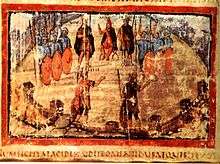Vergilius Vaticanus
The Vergilius Vaticanus or Vatican Virgil (Vatican, Biblioteca Apostolica, Cod. Vat. lat. 3225) is a Late Antique illuminated manuscript containing, in its form today, fragments of Virgil's Aeneid and Georgics. It was made in Rome in about 400,[1] and is one of the oldest surviving sources for the text of the Aeneid and is the oldest and one of only three ancient illustrated manuscripts of classical literature. The two other surviving illustrated manuscripts of classical literature are the Vergilius Romanus and the Ambrosian Iliad.

There are 76 surviving leaves in the manuscript with 50 illustrations. If, as was common practice at the time, the manuscript contained all of the canonical works of Virgil, the manuscript would originally had about 440 leaves and 280 illustrations. The text was written by a single scribe in rustic capitals. As was common at the time, there is no separation between words. The scribe worked first leaving spaces for the illustrations. The illustrations were added by three different painters, all of whom used iconographic copybooks. The illustrations are contained within frames and include landscapes and architectural and other details. The miniatures are set within the text column, although a few miniatures occupy a full page. The human figures are painted in classical style with natural proportions and drawn with vivacity. The illustrations often convey the illusion of depth quite well. The gray ground of the landscapes blend into bands of rose, violet, or blue to give the impression of a hazy distance. The interior scenes are based on earlier understanding of perspective, but occasional errors suggest that the artists did not fully understand the models used. The style of these miniatures has much in common with the surviving miniatures of the Quedlinburg Itala fragment and have also been compared to the frescos found at Pompeii.
The manuscript was probably made for a pagan noble. Annotations in the manuscript indicate it was in Italy until the 7th century and in Tours in the second quarter of the 9th century. A French scribe made further notes around 1400. Later it reached Rome, and belonged to collectors including Pietro Bembo and Fulvio Orsini, who bequeathed it to the Vatican Library in 1600.[2]
The Vergilius Vaticanus is not to be confused with the Vergilius Romanus (Vatican City, Biblioteca Apostolica, Cod. Vat. lat. 3867) or the unillustrated Vergilius Augusteus, two other ancient Vergilian manuscripts in the Biblioteca Apostolica.
Facsimiles
Print Facsimile: Wright, David H. Vergilius Vaticanus: vollständige Faksimile-Ausgabe im Originalformat des Codex Vaticanus Latinus 3225 der Biblioteca Apostolica Vaticana. Graz, Austria: Akademische Druck- u. Verlagsanstalt, 1984.
Digital Facsimile: Vatican Library
All the illustrations are online, with commentary, in Wright, David H., The Vatican Vergil, a Masterpiece of Late Antique Art, Berkeley, University of California Press, 1993, google books, full online text
Notes
References
| Wikimedia Commons has media related to Vatican Vergil. |
- Calkins, Robert G. Illuminated Books of the Middle Ages. Ithaca, New York: Cornell University Press, 1983.
- Walther, Ingo F. and Norbert Wolf. Codices Illustres: The world's most famous illuminated manuscripts, 400 to 1600. Köln, TASCHEN, 2005.
- Weitzmann, Kurt. Late Antique and Early Christian Book Illumination. New York: George Braziller, 1977.
- Weitzmann, Kurt, ed., Age of spirituality: late antique and early Christian art, third to seventh century, no. 203 & 224, 1979, Metropolitan Museum of Art, New York, ISBN 9780870991790; full text available online from The Metropolitan Museum of Art Libraries
Further reading
- Stevenson, Thomas B. Miniature decoration in the Vatican Virgil : a study in late antique iconography. Tübingen, Verlag E. Wasmuth, 1983.
- David Wright, “From Copy to Facsimile: A Millennium of Studying the Vatican Vergil,” The British Library Journal, Vol. 17, No. 1 (Spring 1991), 12-35.
- Wright, David H., The Vatican Vergil, a Masterpiece of Late Antique Art . Berkeley, University of California Press, 1993, google books, full online text
- Wright, David H. Codicological notes on the Vergilius Romanus (Vat. lat. 3867). Vatican City, Biblioteca apostolica vaticana, 1992.
